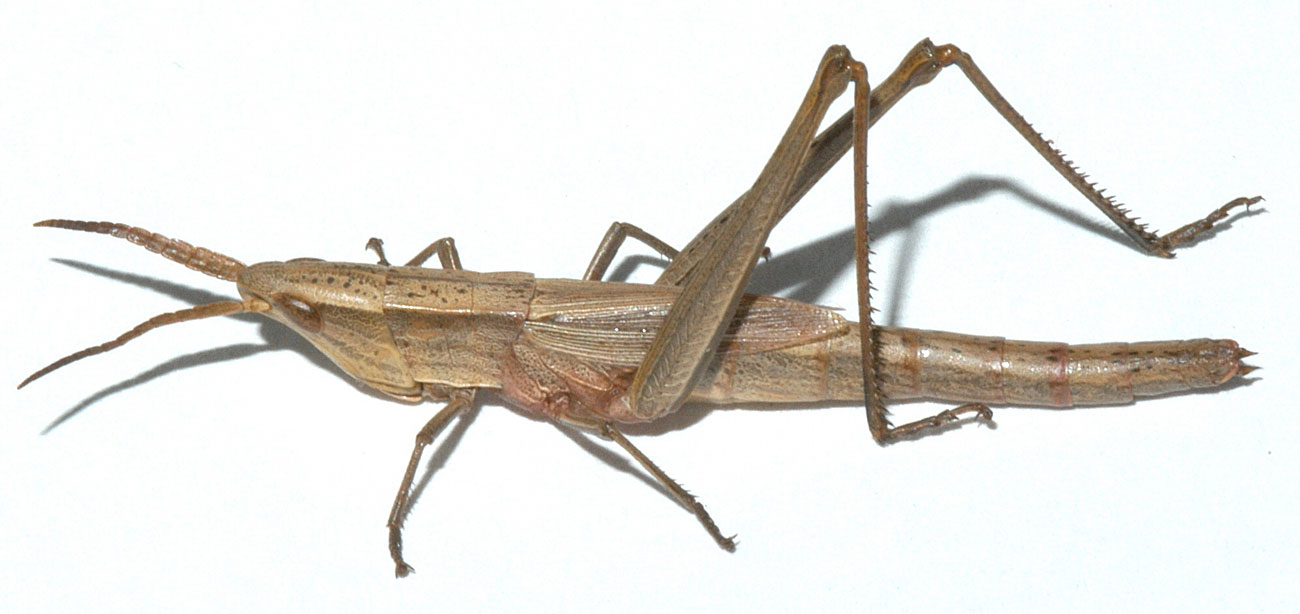Pseudopomala brachyptera
|
Geographic range of Pseudopomala brachyptera (Scudder) |
|
Fig. 1, adult male: BL 26-34, FL 14-17 mm, AS 19-22 |
|
Fig. 2, adult female: BL 33-40 mm, FL 16-20 mm, AS 20-23 |
Species
Short-winged toothpick grasshopper
Pseudopomala brachyptera (Scudder)
Subfamily Gomphocerinae
Identification
The adults of this grasshopper are moderately large and very slender in appearance. The females are only moderately larger than males. The wings of the male extend two-thirds to three-quarters the length to the end of the abdomen, while in the females they extend one-half to one-third of the length. Females with full-length wings are rare. As with the Wyoming toothpick grasshopper the head is distinctly cone-shaped, and the subgenital plate of the male is long and pointed. The general color of the males is brown to rusty brown, with the abdomen often yellowish. The females are more grayish brown in color and of a generally lighter hue than the males. In both sexes there is a somewhat indistinct stripe extending from behind the eye along the sides of the pronotum. The antennae are distinctly ensiform. The front two pairs of legs are not unusually short as in the Wyoming toothpick grasshopper.
Distribution and habitat
The short-winged toothpick grasshopper ranges primarily across the northern half of the United States. It is found from southern Maine and New Jersey through Missouri and Minnesota, west and south to northern Texas, northern Utah, western Washington, and British Columbia. It is known to be not uncommon locally in waste lands and among grasses of poor soil. In the drier portions of the west it is usually found along streams and irrigated tracts. Usually prefers areas with tall bunchgrasses such as Andropogon. It is believed that the tallgrass prairies of the United States represent the primary area of its distribution. In Nebraska it is reportedly most common in sandy regions and in tracts not recently burned over. It can also occur in shrubby areas, often in wooded surroundings.
Economic importance
It can be moderately abundant where found but is never numerous over large areas. While it feeds almost exclusively on grasses, it is local and usually somewhat uncommon and thus, not expected to be of any economic importance.
Food preferences
A total of 7 grasses and two sedges have been found in crop analyses of this grasshopper. Grasses ingested included Agropyron repens, Andropogon scoparius, Bouteloua gracilis, Hordeum jubatum, Panicum virgatum, Poa pratensis, and Spartina pectinata. In Montana it is usually found in moist areas among Agropyron smithii, its chief host there. In food preference tests this grasshopper chose Agropyron repens, Carex stricta, Poa compressa, Agrostis alba, and Poa pratensis in decreasing order. Poa pratensis and Sporobolus asper are commonly ingested.
Dispersal and migration
The dispersal ability of this grasshopper has not been studied in detail. It is a strong leaper, and this is especially true of the males. Often seeks safely by sliding around grasses stems to other side rather than by active retreat. Long-winged females are uncommon, but have been observed to fly for several feet. It is doubtful that it is capable of dispersing long distances.
Hatching
Because adults can be common by late June, it is suspected that nymphs are likely in the intermediate hatching group.
Nymphal development
The immature stages of the short-winged toothpick grasshopper have not been studied in detail.
Adults and reproduction
Adults likely remain in the same areas as nymphs develop. Adults are most common in July and August in many areas, but have been noted commonly as early as June 20 in Nebraska. Records from South Dakota are from July 29 to September 7. Males sing frequently when approaching females.
Population ecology
The population ecology of this grasshopper has not been studied in detail. It is nearly always local in distribution and only common within limited areas.
Daily activity
The daily activity of the short-winged toothpick grasshopper remains poorly studied.
Source and date
University of Nebraska March 2007 by Mathew L. Brust
Selected references
Blatchley, W. S. 1920. Orthoptera of Northeastern America, with especial reference to the faunas of Indiana and Florida. The Nature Publishing Company, Indianapolis, Indiana. 784 pp.
Brooks, A. R. 1958. Acridoidea of southern Alberta, Saskatchewan, and Manitoba. Supplement 9, Canadian Entomologist 90: 1-92.
Bruner, L. 1897. The grasshoppers that occur in Nebraska. Annual Report Entomology, Nebraska State Building of Agriculture, 1897. pp. 105-135.
Cantrall, I. J. 1943. The ecology of the Orthoptera and Dermaptera of the George Reserve, Michigan. Miscellaneous Publications of the University of Michigan Museum of Zoology 54: 1-184.
Fox, H. 1914. Data on the Orthopteran faunistics of eastern Pennsylvania and southern New Jersey. Proceedings of the Academy of Natural Sciences of Philadelphia 1914: 441-534.
Gangwere, S. K. 1961. A monograph on food selection in Orthoptera. Transactions of the American Entomological Society 87: 67-230.
Hebard, M. 1925. The Orthoptera of South Dakota. Proceedings of the Academy of Natural Sciences, Philadelphia 77: 35-155.
Helfer, J. R. 1987. How to Know the Grasshoppers, Crickets, Cockroaches and Their Allies. Dover Publications Inc. New York, New York. 363 pp.
Mulkern, G. B., K. P. Pruess, H. Knutson, A. F. Hagen, J. B. Campbell, and J. D. Lambley. 1969. Food habits and preferences of grassland grasshoppers of the north central Great Plains. North Dakota State University Agricultural Experiment Station, North Central Regional Publication no. 196. 32 pp.
Otte, D. 1970. A comparative study of communicative behavior in grasshoppers. Miscellaneous Publications of the University of Michigan Museum of Zoology no. 141: 1-168.
Otte, D. 1981. The North American grasshoppers, Volume I, Acrididae: Gomphocerinae and Acridinae. Harvard University Press, Cambridge, Massachusetts. 368 pp.


